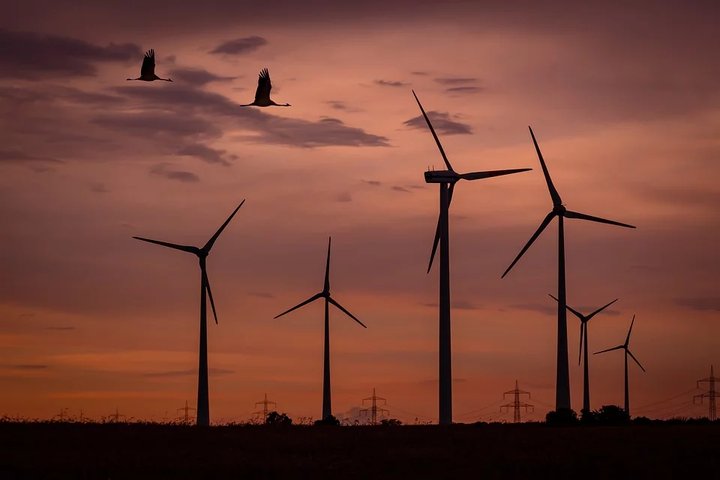
Photo from Pixabay
See also: OP-ED: Adequately Mitigated, the Humboldt Wind Energy Project Would be an Urgently Needed Response to Climate Change, Says Friends of the Eel
# # #
Below is a joint press release from the American Bird Conservatory (ABC), the Environmental Protection Information Center (EPIC) and the Northcoast Environmental Center (NEC):
The Humboldt Wind Energy Project proposes to place 47 wind turbines on Bear River and Monument Ridges in Humboldt County, California.
This proposed project poses substantial risks to federally Threatened species, such as Marbled Murrelet and Spotted Owl, as well as other species of conservation concern such as Bald and Golden Eagle, all of which reproduce slowly and are vulnerable to loss of individuals to collisions with turbines.
Other concerns have also been raised by experts, including questionable calculations of the numbers of Threatened birds likely to be killed by the turbines; inadequate proposed measures to compensate for mortality of birds and other wildlife; and insufficient accountability for long-term monitoring and protection of wildlife. Despite this, the proposal has moved forward quickly over the last 18 months and may be approved as early as Thursday, November 14.
“It’s hard to conceive of a worse place to put wind turbines,” said Joel Merriman, Director of the Bird-Smart Wind Energy Program at American Bird Conservancy (ABC). “ABC supports wind energy projects that provide adequate protections for birds. The Humboldt Wind Energy Project doesn’t come close. In its 37-page comment letter, the California Department of Fish and Wildlife indicated that ‘all or portions of the wind turbine facilities fall into Category 4, Project Sites Inappropriate for Wind Development.’ We couldn’t agree more.”
The Draft Environmental Impact Report (DEIR) on the Humboldt project was released in April 2019 and received many comments and suggestions from local experts that would have reduced impacts to birds and other wildlife. These have largely gone unheeded in the Final EIR (FEIR).
Despite this, the Humboldt County Planning Commission held a public hearing on November 7 and will hold a second on November 14, with a possible vote for project approval on the 14th. The project has been put on a fast track: Stakeholders had only four business days to review the FEIR before the first hearing and will have only nine days before the hearing where the proposal may be approved. Reviewing the FEIR is no small task, since the combined documents amount to hundreds of pages.
“The Northcoast Environmental Center (NEC), along with many concerned citizens, participated in commenting on the Terra-Gen Humboldt Wind Energy Project DEIR,” said Larry Glass, President and Executive Director of the NEC. “Whether you support this project or you have serious questions about it, the developer’s response to public comments printed in the FEIR is completely inadequate. Many of the issues of concern to the NEC and others were dismissed or not sufficiently responded to. This document should be withdrawn until adequate responses can be provided.”
“This proposed project site overlaps the National Audubon Society-designated Cape Mendocino Grasslands Important Bird Area,” said Merriman. “It’s also a hotspot for hawks and eagles. It’s close to Marbled Murrelet critical habitat. Marbled Murrelets and Spotted Owls are known to be present in the area. The list of concerns goes on and on.”
“Because of the high likely impacts given the sensitive area, the public rightly demands that all feasible technology to avoid and minimize impacts be implemented before considering approval,” said Tom Wheeler, Executive Director of the Environmental Protection Information Center (EPIC). “But too many proven measures have been left on the table — things that have been adopted, often voluntarily, at other wind projects. We expect better here in Humboldt.”
In contrast, the Skookumchuck Wind Energy Project in western Washington State is the only approved wind energy project in the Marbled Murrelet’s breeding range. This project was required to curtail (turn off) turbines during high activity periods in the Marbled Murrelet breeding season. The Humboldt project, on the other hand, dismissed the idea of curtailment entirely, ignoring best practices and industry precedent despite posing a significant risk for a multitude of species.
ABC, EPIC, and the NEC support thoughtfully planned wind energy projects that incorporate adequate protections for birds. These organizations acknowledge the role of wind energy in combating climate change, but maintain that wind energy must be developed in a way that does not cause new environmental problems.
“This proposed project does not provide enough information, proposes inadequate mitigation, and ignores precedent and best practices. This puts too many rare and iconic bird and other wildlife species at unnecessary risk,” said Merriman. “We urge the Humboldt County Planning Commission to please send this project back to the drawing board until an acceptable proposal can be developed.”
# # #
American Bird Conservancy is a non-profit organization dedicated to conserving birds and their habitats throughout the Americas. With an emphasis on achieving results and working in partnership, we take on the greatest problems facing birds today, innovating and building on rapid advancements in science to halt extinctions, protect habitats, eliminate threats, and build capacity for bird conservation. Find us on abcbirds.org, Facebook, Instagram, and Twitter (@ABCbirds).
The Environmental Protection Information Center (EPIC) advocates for the protection and restoration of Northwest California’s forests, using an integrated, science-based approach, combining public education, citizen advocacy, and strategic litigation.
The Northcoast Environmental Center has engaged in conservation and environmental protection in northwestern California for over 47 years. Our mission includes educating agencies and the public about environmental concerns that may have an effect on our local resources and citizens.
CLICK TO MANAGE